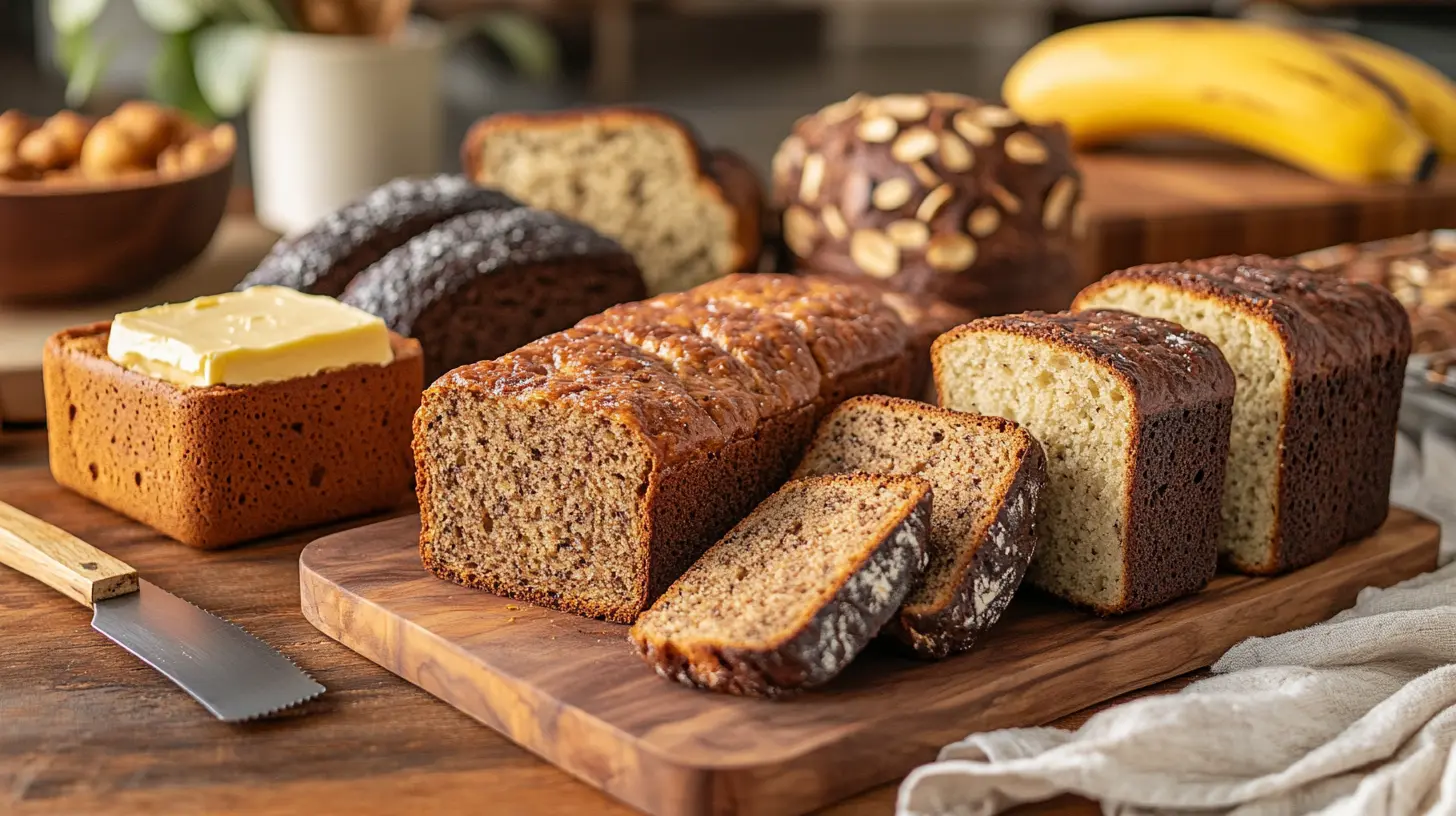A Comprehensive Guide to Delicious and Healthy Choices
Introduction
In today’s world of ever-evolving food trends, few things have captured the attention of health-conscious eaters like low carb bread. Whether you’re following a keto diet, aiming to control your blood sugar levels, or simply want a lighter alternative to traditional bread, low carb bread offers a versatile and delicious solution.
This guide dives deep into the world of low carb bread, exploring its benefits, varieties, and how you can make it part of your daily routine. From satisfying snacks to unique recipes, we’ll show you how to embrace low carb bread without compromising on taste or texture.
By the end of this article, you’ll not only understand the nuances of low carb bread but also feel confident enough to bake your own or choose the best options available. So, let’s get started!
Table of contents
Understanding Low Carb Bread
What Is Low Carb Bread?
Low carb bread is exactly what it sounds like—a bread option that contains significantly fewer carbohydrates than traditional bread. Instead of being made with high-carb wheat flour, low carb bread typically uses almond flour, coconut flour, or other low-carb substitutes.
Why It’s Gaining Popularity
Low carb bread has gained traction because it aligns with diets like keto, paleo, and Atkins, which prioritize low-carb intake. Additionally, many people turn to low carb bread to manage conditions like diabetes or to support weight management.
Why Choose Low Carb Bread?
- Health Benefits: Low carb bread can stabilize blood sugar levels, reduce energy crashes, and help control hunger.
- Diet-Friendly: Perfect for those on keto, paleo, or gluten-free diets.
- Versatility: Can be used in everything from sandwiches to breakfast toast and even breadcrumbs.
Common Ingredients in Low Carb Bread
Here are some staples you’ll see in low carb bread recipes:
- Almond Flour: Rich in healthy fats and naturally low in carbs.
- Coconut Flour: High in fiber and gives a subtly sweet flavor.
- Psyllium Husk: Adds structure and helps mimic the texture of traditional bread.
- Eggs and Cheese: Commonly used as binders to improve texture and protein content.
Exploring Low Carb Banana Bread Variants
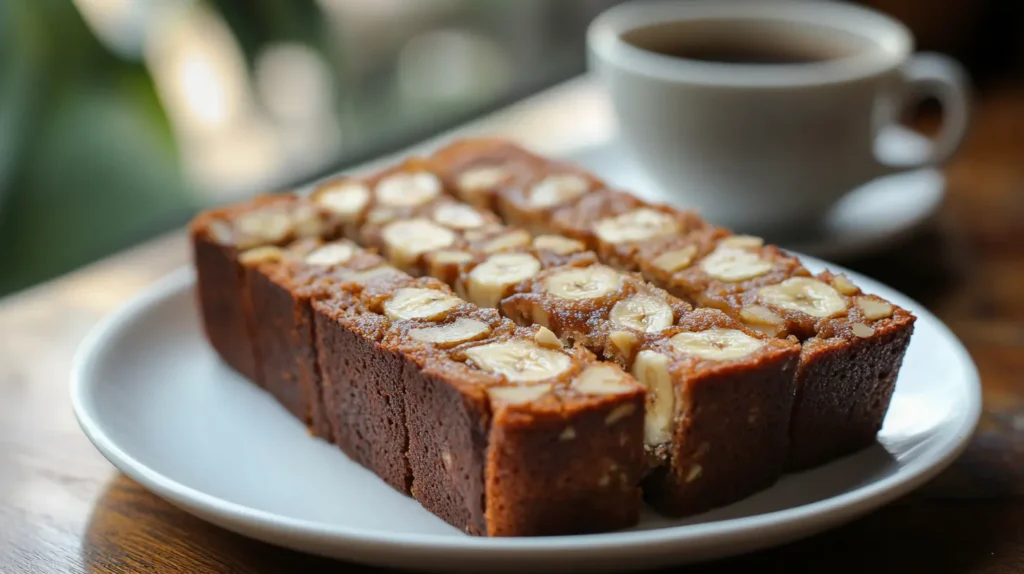
Who doesn’t love the comforting taste of banana bread? The sweet, moist texture makes it a household favorite. The challenge? Traditional banana bread is loaded with sugar and carbs. But don’t worry—there are creative ways to enjoy banana bread without compromising your low-carb lifestyle. Let’s explore a few irresistible options.
Banana Bread at Work: A Quick Snack
Picture this: You’re rushing through your busy day, and hunger strikes. Enter low carb banana bread! It’s not just a treat; it’s a portable and nutritious snack that’s perfect for the office or on-the-go.
Why It Works:
- Easy to Pack: Slice it up, wrap it in parchment paper, and it’s ready for the lunchbox.
- Filling and Satisfying: The combination of fiber and protein keeps you full longer, reducing the temptation to snack on unhealthy alternatives.
- Customizable: Add a handful of nuts, sugar-free chocolate chips, or even a dash of cinnamon for variety.
4-Ingredient Banana Bread Recipe
When time is tight, a quick and easy recipe can be a lifesaver. This 4-ingredient banana bread delivers all the taste without the hassle.
Ingredients:
- 2 ripe bananas (medium-sized)
- 2 large eggs
- 1 cup almond flour
- 1 tsp baking powder
Instructions:
- Preheat your oven to 350°F (175°C) and grease a small loaf pan.
- Mash the bananas in a bowl until smooth.
- Whisk in the eggs, then fold in the almond flour and baking powder.
- Pour the batter into the loaf pan and bake for 25–30 minutes, or until a toothpick comes out clean.
This simple recipe is naturally gluten-free, low in carbs, and rich in flavor. Plus, it’s the perfect way to use up overripe bananas!
3-Ingredient Banana Bread Recipe
For those who love simplicity, the 3-ingredient banana bread recipe is a must-try. It’s a minimalist approach to indulgence.
Ingredients:
- 2 ripe bananas
- 2 large eggs
- 3/4 cup almond flour
Instructions:
- Follow the same steps as the 4-ingredient recipe but omit the baking powder.
- This version is denser and slightly moister, making it great for a quick snack or breakfast.
Pro Tip: Add a sprinkle of flaxseeds or chia seeds on top before baking to give it an extra nutritional boost.
Banana Bread for Everyone
Low carb banana bread isn’t just for those on specific diets. Its versatility makes it a crowd-pleaser. Serve it as a breakfast staple, an afternoon snack, or a guilt-free dessert. With these recipes, you’ll never feel like you’re missing out on the joys of banana bread.
Gluten-Free Bread Options
For anyone with gluten sensitivities or those simply wanting to explore healthier alternatives, gluten-free low carb bread is a game-changer. Whether you’re baking your own or looking for store-bought options, these breads offer the perfect balance of taste, texture, and nutrition.
Gluten-Free Bread Crumbs: A Pantry Essential
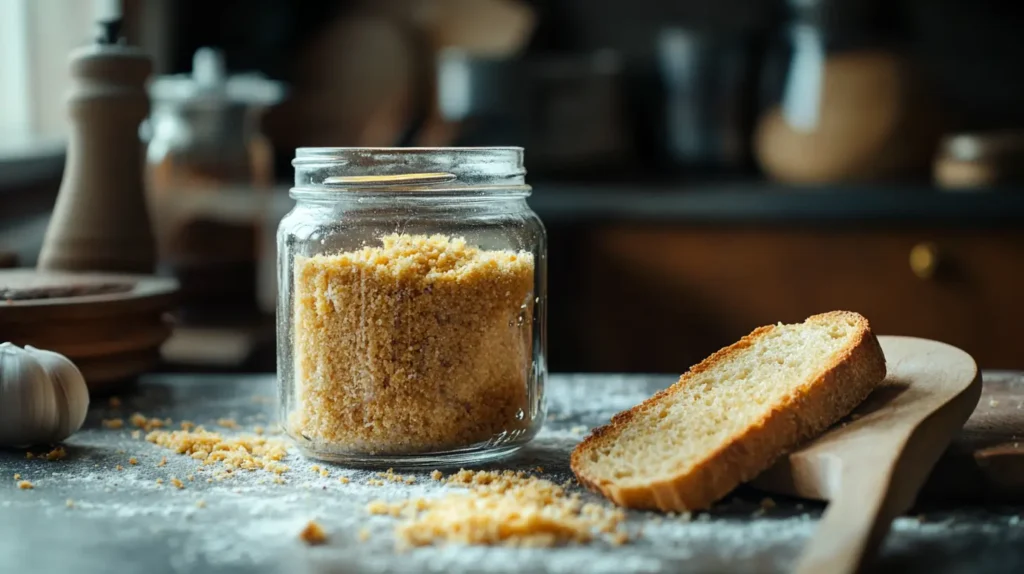
Ever tried a recipe that called for bread crumbs, only to realize they don’t fit into your low-carb or gluten-free lifestyle? That’s where gluten-free bread crumbs come to the rescue.
Why Gluten-Free Bread Crumbs Matter:
- Versatility: Ideal for breading chicken, topping casseroles, or thickening soups.
- Health Benefits: Made from low carb ingredients like almond or coconut flour, they are lower in carbs and calories.
- Easy to Make at Home: You can turn leftover slices of gluten-free bread into crumbs with minimal effort.
How to Make Gluten-Free Low Carb Bread Crumbs:
- Choose Your Base: Use slices of gluten-free low carb bread, such as those made with almond or flaxseed flour.
- Toast the Bread: Bake the slices at 300°F (150°C) for 15–20 minutes until they’re golden and crisp.
- Blend or Crush: Once cooled, pulse the toasted bread in a food processor or crush it with a rolling pin.
- Store and Use: Keep your bread crumbs in an airtight container for up to a month.
These homemade gluten-free bread crumbs are perfect for coating chicken, zucchini fries, or even as a savory sprinkle on baked dishes.
Protein-Packed Low Carb Bread
Protein lovers, rejoice! Not all bread is created equal, and some low carb options go the extra mile by packing in more protein.
What Makes It Special?
- High Protein Content: Using ingredients like eggs, whey protein powder, and cottage cheese boosts the protein levels.
- Keto-Friendly: These breads often have less than 3g net carbs per slice, making them ideal for ketogenic diets.
- Improved Satiety: The added protein helps you feel fuller for longer.
Quick Recipe: Protein Bread
If you want to try making your own, here’s a simple recipe:
Ingredients:
- 1/2 cup almond flour
- 1/2 cup whey protein isolate
- 2 tbsp psyllium husk powder
- 1 tsp baking powder
- 3 large eggs
- 1/4 cup water or almond milk
Instructions:
- Preheat your oven to 350°F (175°C) and grease a loaf pan.
- Mix all dry ingredients in a bowl.
- Whisk the eggs and water (or almond milk) in a separate bowl, then fold into the dry mixture.
- Pour the batter into the pan and bake for 25–30 minutes until golden brown.
This bread has a dense texture, making it perfect for sandwiches or even as a burger bun replacement.
Benefits of Gluten-Free Low Carb Breads
- Digestive Health: Gluten-free options are easier on the stomach for those with sensitivities.
- Lower Carb Counts: With fewer carbs than traditional bread, these options are great for managing blood sugar.
- Rich in Nutrients: Many low carb gluten-free breads include nutrient-dense ingredients like chia seeds, flaxseed, and almond flour.
With these gluten-free and protein-rich choices, you can enjoy bread that fits into your health goals without sacrificing flavor.
Comparative Nutritional Benefits of Low Carb Bread
When deciding between low carb bread and traditional bread, it helps to understand how they stack up nutritionally. Low carb bread offers unique advantages that can make it a healthier and more satisfying choice, especially for those focused on weight management, energy stability, or specific dietary needs.
Fewer Carbs, More Energy Stability
One of the standout benefits of low carb bread is its significantly reduced carbohydrate content. Traditional bread often contains 15–20 grams of carbs per slice, while low carb varieties can have as little as 2–5 grams.
Why Fewer Carbs Matter:
- Prevents Sugar Spikes: Low carb bread minimizes rapid spikes in blood sugar, which are common with traditional bread made from refined flours.
- Steady Energy Levels: By reducing the glycemic impact, low carb bread provides a more consistent energy supply throughout the day.
- Supports Ketogenic Lifestyles: For those following keto or low-carb diets, it’s an essential part of staying in ketosis.
Higher Fiber Content for Digestive Health
Many low carb bread recipes incorporate high-fiber ingredients like psyllium husk, flaxseeds, or chia seeds. In contrast, traditional bread often lacks substantial fiber unless specifically marketed as whole grain.
Fiber Benefits:
- Improved Digestion: Fiber promotes regularity and supports a healthy gut.
- Increased Satiety: High-fiber foods help you feel fuller for longer, reducing the likelihood of overeating.
- Better Blood Sugar Control: Dietary fiber slows the absorption of sugar, further aiding blood sugar stability.
For example, a slice of low carb bread might contain 5–7 grams of fiber compared to just 1–3 grams in a typical white or wheat bread slice.
Protein Power: Boosting Muscle and Recovery
Low carb bread often includes higher protein levels, thanks to ingredients like eggs, whey protein, or almond flour. Protein is vital for muscle repair, energy, and overall health.
How Low Carb Bread Adds Protein:
- Traditional bread contains 2–3 grams of protein per slice.
- Low carb bread can pack in 5–10 grams of protein per slice, depending on the recipe.
Who Benefits Most:
- Athletes: Helps with post-workout recovery.
- Weight Loss Seekers: Protein helps reduce hunger hormones and boost metabolism.
- Busy Professionals: Provides long-lasting energy for busy days.
Calorie Comparisons: A Better Choice for Weight Management
While low carb bread isn’t always lower in calories, it can still be a better choice for those managing their weight. This is because it typically keeps you fuller longer, helping you reduce overall calorie intake throughout the day.
Example:
- Traditional White Bread: ~80–100 calories per slice, low fiber, and quick to digest.
- Low Carb Bread: ~50–90 calories per slice, higher in fiber and protein, leading to longer satiety.
Nutritional Versatility
Low carb bread isn’t just about reducing carbs—it’s about packing in more nutrients. Many recipes include:
- Healthy Fats: Ingredients like almond or coconut flour are rich in healthy fats, which provide energy and support heart health.
- Essential Minerals: Flaxseeds and chia seeds add magnesium, calcium, and omega-3s.
- Natural Sweeteners: Sugar-free options use stevia or erythritol, keeping the glycemic index low.
Making the Switch
Switching to low carb bread doesn’t mean giving up on taste or versatility. Instead, it’s an opportunity to choose a nutrient-dense alternative that supports your health goals. With fewer carbs, more fiber, and added protein, low carb bread can easily become a staple in your kitchen.
Specialty Low Carb Breads
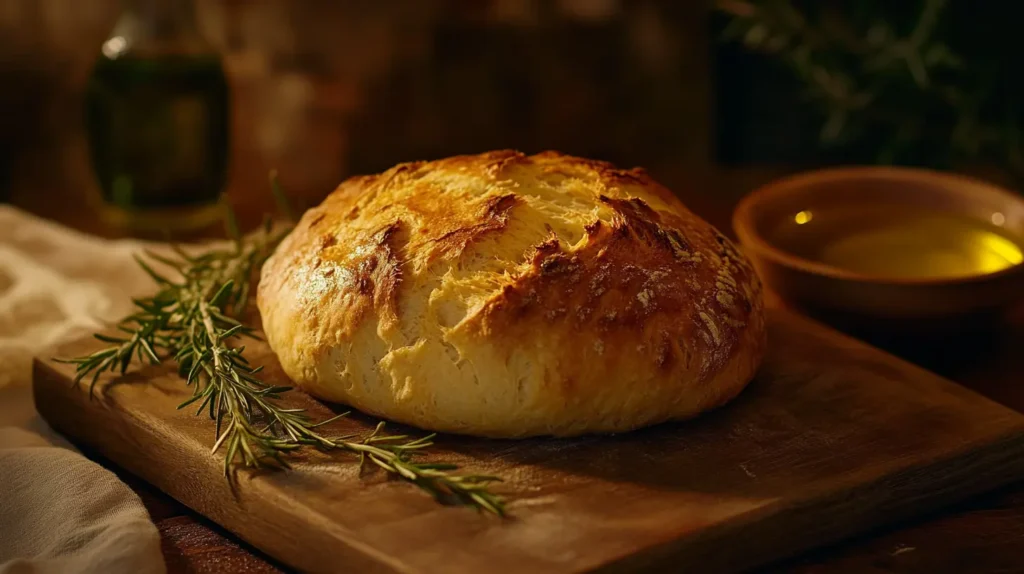
For those who love variety and gourmet flavors, specialty low carb breads bring an exciting twist to the table. These breads are perfect for elevating everyday meals or indulging in a flavorful, health-conscious treat. Let’s explore some of the most popular options, including artisan Italian low carb bread and a high-protein cottage cheese bread recipe.
Artisan Italian Low Carb Bread
Imagine the rustic, crusty texture of Italian bread but with a low carb makeover. Artisan Italian low carb bread is perfect for pairing with soups, salads, or even making garlic bread that fits your diet.
What Makes It Special:
- Rustic Crust: Achieved by using almond or oat fiber and baking at high heat.
- Rich Flavor: Infused with herbs like rosemary or thyme for a classic Italian touch.
- Versatility: Great for dipping in olive oil, as sandwich bread, or as a side for pasta alternatives like zucchini noodles.
Simple Recipe: Artisan Italian Low Carb Bread
Ingredients:
- 2 cups almond flour
- 1/4 cup oat fiber (optional, for a lighter texture)
- 2 tbsp psyllium husk powder
- 1 tsp baking powder
- 1/2 tsp salt
- 3 large eggs
- 1/4 cup olive oil
- 1/4 cup warm water
Instructions:
- Preheat your oven to 375°F (190°C).
- Mix dry ingredients in a bowl. In a separate bowl, whisk eggs, olive oil, and warm water.
- Combine wet and dry ingredients to form a dough. Shape into a round loaf or baguette.
- Place on a lined baking sheet and bake for 25–30 minutes until golden brown and crusty.
This bread offers the rich aroma and flavor of traditional Italian bread while keeping carbs in check.
Cottage Cheese Bread Recipe
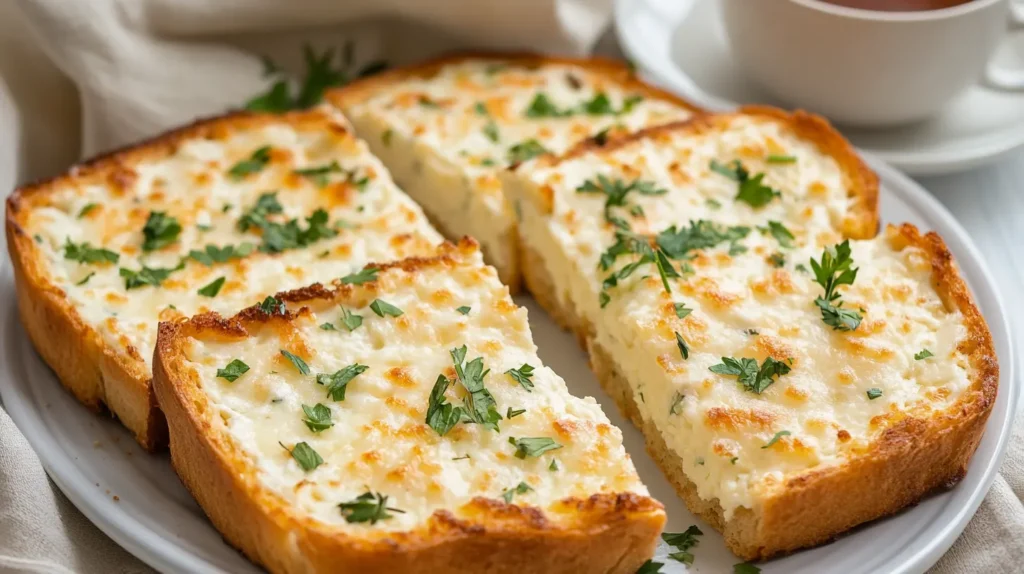
Looking for a high-protein bread that’s creamy and delicious? Cottage cheese bread is a fantastic low carb option. Its soft, dense texture is perfect for breakfast or a mid-day snack.
Why Cottage Cheese?
- Protein Boost: Cottage cheese provides a substantial amount of protein in every slice.
- Moist Texture: Keeps the bread soft and prevents it from drying out.
- Easy Preparation: Simple ingredients and quick to bake.
Quick Recipe:
Ingredients:
- 1 cup almond flour
- 1/2 cup cottage cheese
- 3 eggs
- 1 tsp baking powder
- 1/4 tsp salt
- Optional: Add herbs like dill or garlic powder for flavor.
Instructions:
- Preheat your oven to 350°F (175°C) and grease a loaf pan.
- Blend cottage cheese, eggs, and salt in a food processor or blender until smooth.
- In a bowl, combine almond flour and baking powder. Add the wet mixture and stir until well combined.
- Pour into the loaf pan and bake for 25–30 minutes until the top is golden.
This bread pairs wonderfully with cream cheese spreads, avocado, or even as a base for open-faced sandwiches.
Specialty Breads for Every Occasion
Whether it’s a special dinner or a quick snack, specialty low carb breads add a gourmet touch to your menu while staying aligned with your health goals. From the crusty charm of artisan Italian bread to the creamy richness of cottage cheese bread, these options are sure to impress.
Tips for Serving and Storing Low Carb Bread
Low carb bread is not only delicious but also versatile. Whether you’re serving it as part of a meal or storing it for later, the right techniques can make all the difference. Here’s how to get the most out of your bread.
The Perfect Slice of Bread: Cutting and Serving Tips
Serving low carb bread can sometimes require a little extra care since it’s often denser or more delicate than traditional bread.
Tips for Cutting and Serving:
- Use a Serrated Knife: A serrated bread knife works best for clean, even slices without crumbling.
- Let It Cool Completely: If you’ve just baked your bread, allow it to cool completely before slicing to maintain its structure.
- Serve with Spreads and Toppings: Enhance the flavor with keto-friendly spreads like cream cheese, almond butter, or avocado. For savory bread, add toppings like smoked salmon or turkey slices.
Serving Suggestions:
- Breakfast: Toast a slice and top it with a poached egg or sugar-free jam.
- Lunch: Use it for low-carb sandwiches with your favorite fillings.
- Snacks: Pair it with soups or salads for a satisfying, low-carb side.
Storing Low Carb Bread for Long-Lasting Freshness
Low carb bread tends to have fewer preservatives, so proper storage is essential to maintain its freshness and texture.
Short-Term Storage:
- Keep your bread in an airtight container or a zip-top bag at room temperature for up to 2–3 days.
- Add a paper towel inside the bag to absorb moisture and prevent sogginess.
Refrigeration:
- If you don’t plan to consume the bread within a few days, store it in the refrigerator to extend its shelf life up to a week.
- Wrap the bread tightly to avoid it drying out.
Freezing Low Carb Bread:
- Slice the bread before freezing. This way, you can grab just what you need without defrosting the entire loaf.
- Wrap each slice in parchment paper, then place them in a freezer-safe bag. Low carb bread can last up to 3 months in the freezer.
Reheating Tips:
- Use a toaster or toaster oven to warm slices directly from the freezer.
- Avoid microwaving for too long, as it can make the bread rubbery.
Keeping Bread Fresh and Flavorful
By storing and serving your bread properly, you’ll enjoy every bite just as much as the first. Whether it’s a quick toast in the morning or a hearty sandwich for lunch, these tips ensure your low carb bread stays fresh and delicious.
FAQs:
To wrap up, let’s address some frequently asked questions about low carb bread.
Can Low Carb Bread Help with Weight Loss?
Yes! Low carb bread can be an excellent addition to a weight loss plan because it’s lower in carbs, often higher in protein and fiber, and helps reduce hunger, leading to fewer calories consumed overall.
Is Low Carb Bread Gluten-Free?
Not always. While many low carb breads are also gluten-free, some may use low-carb flours that still contain gluten, such as vital wheat gluten. Always check the ingredient list if you have gluten sensitivities.
Can I Make Low Carb Bread Without Special Equipment?
Absolutely! Most low carb bread recipes can be made with basic kitchen tools like a mixing bowl, whisk, and loaf pan. A food processor can be helpful for blending certain ingredients like cottage cheese, but it’s not a necessity.
Conclusion:
Explore More Bread Inspiration
Bread-making is an art, and with these recipes, you can master it while keeping health and convenience in mind. For a healthier twist, check out high-protein gluten-free bread, gluten-free banana nut bread muffins, and gluten-free turkey dinner. For quick and simple ideas, try how to make gluten-free banana bread, or gluten-free English muffins. Planning a special brunch? Explore gluten-free brunch recipes.
Visit Tons Recipes for even more tips, tricks, and inspiration to elevate your bread-making game!

